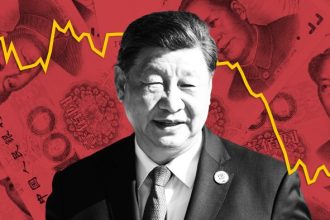Treasury yields soared on Tuesday, with the policy-sensitive 2-year rate jumping its most in nine months, after January’s U.S. consumer-price index report threw financial markets into a tailspin.
What’s happening
-
The yield on the 2-year Treasury note
BX:TMUBMUSD02Y
soared 18.7 basis points to 4.654%, from 4.467% on Monday. Tuesday’s level is the highest since Dec. 12, based on 3 p.m. Eastern time figures from Dow Jones Market Data. The 2-year rate jumped by the most in one day since May 5, 2023. -
The yield on the 10-year Treasury note
BX:TMUBMUSD10Y
jumped 14.5 basis points to 4.315%, from 4.170% on Monday. -
The yield on the 30-year Treasury note
BX:TMUBMUSD30Y
rose 9.6 basis points to 4.466%, from 4.370% on Monday. - Tuesday’s levels are the highest for 10- and 30-year rates since Nov. 30.
What’s driving markets
Data released on Tuesday showed that inflation, as measured by the U.S. consumer-price index, came in hotter than expected for January.
Consumer prices rose 0.3% last month, while the annual headline rate of inflation failed to drop below the 3% threshold as investors had been hoping for.
Even the core rate of inflation, which strips out volatile items like food and energy, rose by a stronger-than-expected 0.4% last month, while the annual core rate was unchanged at 3.9%.
Tuesday’s report came in the wake of a string of evidence recently that the U.S. economy remains strong, and gave investors and traders reason to push back their expectations on the timing of the first interest-rate cut from the Federal Reserve.
Read: ‘Ugly’ and ‘disconcerting’ inflation report upsets markets’ thinking on when Fed will cut rates
Currently, markets are pricing in a 75.8% probability that the Fed will deliver at least a quarter-point rate cut in June, according to the CME FedWatch Tool. They also see an 81.2% chance of at least three rate cuts by December.
Overseas, there was a reminder from the U.K. that inflationary pressures persist. Britain’s Office for National Statistics said that average weekly wages, including bonuses, rose by more than expected toward the end of last year. The U.K. 2-year government-bond yield climbed 13 basis points to 4.681%.
What analysts are saying
“The ‘January effect’ where companies tend to raise prices at the turn of the year was likely one driver of the stronger print, with companies continuing to push price [gains] after another year of strong inflation. Companies that expected prices to rise at a more muted pace in 2023 may have needed to ‘catch up’ and were able to do so given the continued strong pricing environment,” said Josh Jamner, investment strategy analyst at ClearBridge Investments in New York, which managed $176.6 billion in assets as of December.
Read the full article here





